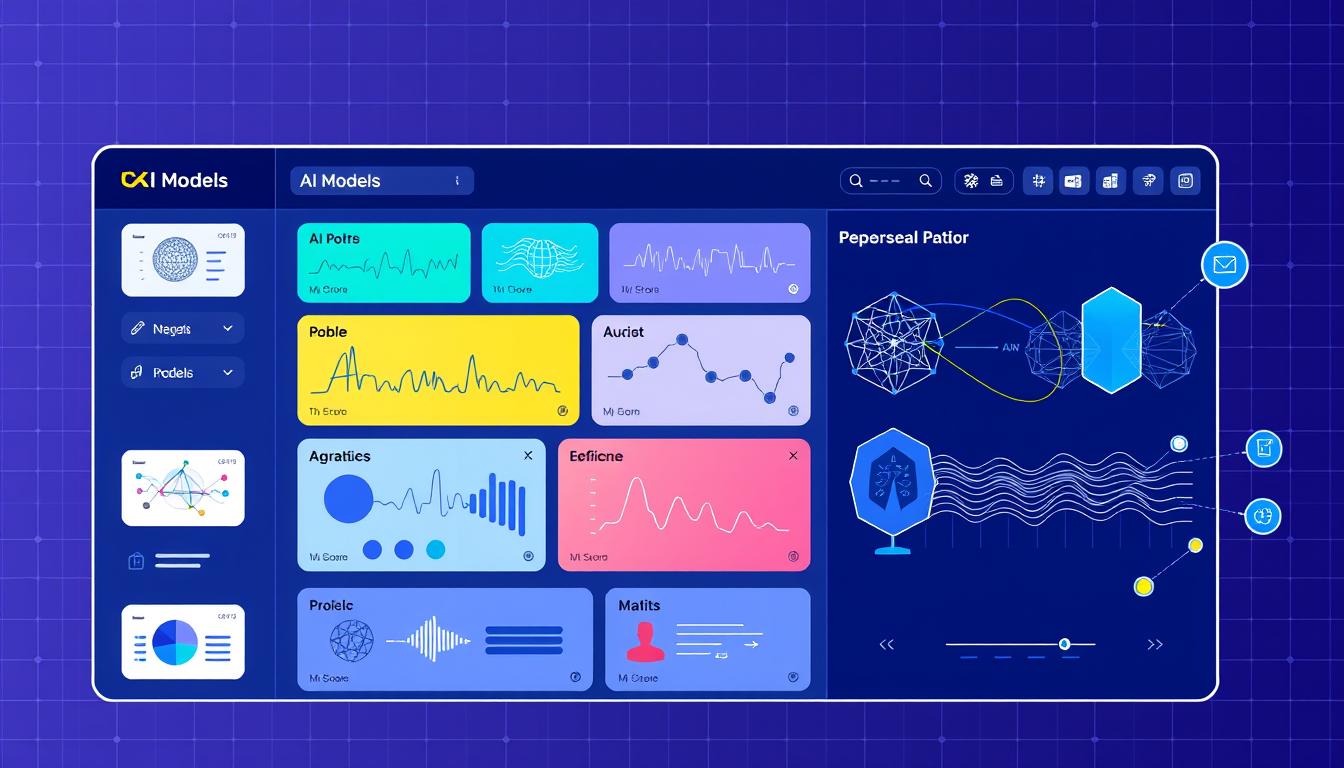What is Ollama: AI Model Management Made Simple
Ever thought about running advanced AI models right on your computer? Ollama makes this possible. It’s an open-source framework that simplifies running large language models on your local machine. Unlike cloud-based AI, Ollama focuses on data privacy, customization, and saving money. This makes AI model management easy for developers and hobbyists.
Ollama offers features like hardware optimization and offline use. It works on macOS, Linux, and Windows, providing a safe space for running LLMs on your computer. This boosts data security and makes it easy to fit into different projects. It’s great for research, personal projects, and more. Want to learn more about Ollama’s impact on AI model management? Read our in-depth guide: Explore Ollama’s innovative features.
Key Takeaways
- What is Ollama? It’s an open-source framework for running large language models locally.
- Ollama enhances data privacy and offers a customizable AI experience.
- Supports multiple platforms including Windows, macOS, and Linux.
- Features hardware optimization and offline operation for seamless integration into various workflows.
- Ollama democratizes access to LLMs, fostering experimentation and learning.
The Basics of Ollama
An introduction to Ollama shows a unique AI model management platform. It makes working with large language models (LLMs) on local systems easier. This tool helps AI developers and businesses by offering features for today’s computing needs. Let’s explore the key ollama basics that make it a top choice in AI management.
Ollama is open-source, making it easy to download, update, and delete models. This is key for those who need to keep data safe and private. Using Ollama locally cuts down on latency and security risks from cloud storage.
Ollama works best on systems with NVIDIA or AMD GPUs. These GPUs help models run smoothly and efficiently. Plus, Ollama works on macOS, Linux, and Windows (in preview), making it accessible to more people.
It supports models like Llama 3.2, Mistral, Code Llama, LLaVA, and Phi-3. Each model is good for different tasks:
- Llama 3.2: Great for NLP and machine translation.
- Mistral: Best for code generation and data analysis.
- Code Llama: Focuses on programming tasks.
- LLaVA: Handles text and images for visual data.
- Phi-3: Good for scientific and research tasks, like literature reviews.
Apple Silicon has made local AI models run better. MacBook Pro users with Apple Silicon chips see better performance and smoother use of Ollama. Using advanced models locally and privately is a big plus over cloud services.
In summary, Ollama offers many benefits. It helps create local chatbots, supports offline research, and ensures privacy in AI. It also fits well into various industries’ workflows.
What is Ollama?
Ollama is a new tool for running large language models (LLMs) offline. It’s open-source and keeps AI operations private and secure. It works on Linux, Windows, and macOS, making it easy for developers to use.
It supports models like Llama 2 and works well with GPUs. This makes it great for running AI models without needing the internet.
Ollama Definition and Meaning
The ollama definition is about running LLMs offline. It uses GPUs to manage and run models safely. This way, users don’t need the cloud to keep their data private and secure.
Ollama packages everything needed for a model into one file. This makes it easy to set up and use.
Core Features of Ollama
Ollama has key features that make it popular among AI developers:
- Model Library: It supports many LLMs, including Llama 2. Users can also fine-tune models.
- Seamless Management: It makes setting up and using models easy, including efficient GPU use.
- Cross-Platform Compatibility: It works on Linux, Windows, and macOS.
Ollama also comes with important dependencies. These are needed for setting up and running projects.
How Ollama Benefits AI Developers
The benefits of Ollama for AI developers are big:
- Control Over Data: It keeps data safe by not using cloud storage.
- Customization: It lets developers fine-tune models for their projects.
- Efficiency: It makes work better by not needing cloud servers, using local resources better.
Ollama is a must-have for AI developers. It offers great features and is easy to set up. It helps developers run AI models efficiently and securely.
The History and Origins of Ollama
Ollama started with a dream to link complex AI tech with easy-to-use tools for everyone. It focuses on privacy and local use, making AI safe and accessible. Michael Chiang and Jeffrey Morgan founded Ollama in Palo Alto, CA. They wanted to bring top AI to users’ devices.
Development Timeline
- Ollama was founded by Michael Chiang and Jeffrey Morgan in Palo Alto, participating in the W21 batch of Y Combinator.
- April 2024: The release of Llama 3, the latest iteration of the Llama model family.
- The Llama models ranging from 7 billion to 65 billion parameters, trained on a vast dataset of text and code.
- Quantization technique introduced to reduce model weight precision, enhancing memory efficiency.
- Llama3-chatqa by NVIDIA and llava-phi3 from Microsoft’s Phi 3 Mini showed advanced capabilities in conversational AI and compact performance.
Founding Vision and Objectives
Ollama’s goal was to make AI accessible to all, focusing on user control and privacy. It aimed to run on various systems like Linux, MacOS, and Windows. This move was different from cloud-based services, offering a secure and customizable AI experience.
Ollama also has an MIT license, encouraging open use and innovation. It shows a wide range of applications, from text and chat to code and vision models. This diversity makes Ollama versatile, speeding up AI tasks, especially with GPU systems.
Key Features of Ollama
Ollama stands out with its key features. It has a huge library of pre-trained large language models (LLMs). These include Llama 3 and Phi-3, with sizes from 2 billion to 70 billion parameters. Models like Gemma (2B, 7B) and Solar (10.7B) let users run AI apps locally.
One big plus of Ollama is running models on personal machines. This boosts data privacy, speeds up processing, and cuts down on server use. Users can easily use tools like Python, LangChain, and LlamaIndex with Ollama.
Ollama also offers hardware acceleration for smooth model operation. It uses unsupervised learning and deep neural networks. This lets models learn language without rules. Plus, setting up Ollama is easy, with guides for Linux, macOS, and Windows.
Customization is key in Ollama. Users can tweak LLMs for their needs, using prompt engineering and few-shot learning. It supports many models, like Llama, Mistral, Code Llama, and Phi-3. These are great for tasks like language processing, code generation, and research.
Performance is another highlight of Ollama. It suggests 16-32GB of RAM for the best results with large models. Running models locally means faster and more private use, better than cloud services.
Ollama is great for many uses, like chatbots, data analysis, research, code help, and education. Its wide range of uses shows Ollama’s value in AI development.
Installing and Setting Up Ollama
Setting up Ollama is easy and straightforward. We’ll guide you through each step, from checking system requirements to the final setup. This Ollama setup guide will get you started quickly.
System Requirements
Before you start installing Ollama, make sure your system is ready. Ollama works on Linux and macOS, with Windows coming soon. Here’s what you need:
- At least 16GB of RAM
- 12GB of disk space
- A CPU with 8 cores for the best performance
- Optional GPUs for better performance with big models
Step-by-Step Installation Guide
- First, download the installation package from the Ollama website.
- For Linux, download a binary package and start the service with these commands:
1
2sudo dpkg -i ollama_latest.deb
sudo systemctl start ollama - Check if the service is running by visiting
1http://127.0.0.1:11434
on your local machine.
Linux users, to update Ollama, just download the new binary package and restart the service.
Initial Configuration and Setup
After installing Ollama, it’s time for the setup. The initial steps are simple, with just a few tweaks needed:
- Start the service with
1ollama --serve
to begin.
- Create a systemd service file for automatic startup on boot:
2
3
4
5
6
7
8
9
10
11
Description=Ollama Service
After=network.target
[Service]
User=root
ExecStart=/usr/local/bin/ollama --serve
Restart=always
[Install]
WantedBy=multi-user.target
- Use
1ollama pull <model_name>
to fetch language models. This downloads and sets up the models for use.
For more specific settings, adjust environmental variables like
1 | OLLAMA_DEBUG |
or
1 | OLLAMA_HOST |
within the Ollama service. This ollama setup guide will help you fine-tune the service for your needs.
Supported Models in Ollama
Ollama supports many popular models, making it great for different AI tasks. These models help with text generation, code automation, and more. You can customize and fine-tune these models right in Ollama.
Overview of Popular Models
Ollama has a variety of AI models for different needs:
- Llama 3: A strong text generation model for natural language tasks.
- Mistral: Great for code automation, working well with coding tools.
- Code Llama: Perfect for multimodal tasks, handling text and images.
- Model sizes vary from 1.4 billion to 405 billion parameters.
- RAM needs range from 8GB for small models to 32GB for big ones.
This variety lets users pick the best model for their projects and resources.
Customization and Fine-Tuning Options
Customizing ollama models is a big plus, offering flexibility. Users can:
- Adjust settings and parameters: Make models fit specific project needs for better performance.
- Implement fine-tuning: Use SFT and RLHF to boost model skills and safety.
- Utilize industry-specific applications: Ollama works with desktops, chat interfaces, web UIs, and productivity AI assistants, all customizable.
This customization ensures ollama models can be tailored for various projects. It’s a key tool for AI developers and researchers.
Practical Use Cases for Ollama
Ollama has many ollama applications for different industries. It’s known for its wide range of uses. This makes it a top choice for many.
One key use is for local AI chats. These chatbots work offline, giving users a smooth experience. They’re great for places with no internet or where data is very private.
Healthcare, law, and finance really benefit from Ollama’s offline features. It helps keep data safe while using AI for tasks like data analysis and creating content.
Ollama’s models, like Llama3, are very good at language tasks. They even beat GPT-3.5 in some tests. They work fast on different computers, making them perfect for many ollama applications.
Ollama also lets users add their own AI models. This is great for companies that need special AI solutions.
Ollama has an HTTP API for making personal apps. This makes it easy for many people to use. It’s fast, responding in under 100ms.
Ollama is used in many ways, like extracting data and analyzing content. It shows how versatile and reliable Ollama is. It meets many tech needs while keeping data safe.
Ollama vs. Cloud-Based AI Solutions
When comparing Ollama to cloud solutions, several key points stand out. Ollama shines in privacy, cost, and performance. This comparison highlights Ollama’s strengths over cloud AI solutions.
Privacy and Data Security
Ollama focuses on privacy and data security. It keeps data on local servers, unlike cloud solutions. This reduces the risk of data breaches and unauthorized access.
Keeping data local protects it within the company’s control. This is crucial for industries with strict data protection rules. Ollama is a privacy-conscious choice.
Cost Efficiency
Ollama is also cost-efficient. Cloud solutions have ongoing fees and scaling costs. Ollama, however, operates locally, saving money.
This makes Ollama a budget-friendly option for many. It uses local hardware to run large language models efficiently and affordably.
Performance and Latency
Ollama excels in performance and latency. Cloud AI solutions face latency due to network delays. Ollama processes data locally, reducing latency and speeding up responses.
In fact, Ollama cuts model inference time by up to 50% compared to cloud platforms. This is crucial for real-time data processing needs.
Ollama also supports GPU acceleration for complex tasks. This boosts performance, making AI model management efficient and cost-effective. Comparing Ollama to cloud solutions shows Ollama’s clear advantages in privacy, cost, and performance.
Running AI Models Locally with Ollama
Ollama lets you run AI models on your own computer. This has big benefits for developers and companies. It keeps your data safe, lets you control your computer’s power, and works offline.
By running models on your own machine, you keep your data safe from the internet. You also get to choose how much power your computer uses. This means you don’t have to rely on others for your needs.
Benefits of Local Execution
One big benefit of local processing with Ollama is keeping your data private. You don’t have to send your data to the internet, so it’s safer. Plus, your computer works faster because it doesn’t have to send data over the internet.
Using your own computer also saves money. It’s cheaper than using cloud services, which cost money every month. Ollama works on MacOS, Linux, and Windows (via WSL2), making it easy for many people to use.

Challenges and Limitations
But, there are some downsides to using Ollama. Running big AI models needs a strong computer. You’ll need lots of RAM, CPU power, and maybe a GPU for the best results. You’ll also need a lot of storage space, about 12GB for the basic setup and more for bigger models.
Another issue is growing your setup. While it’s great for small projects, it’s harder to scale up for big needs. You’ll also have to keep your system updated and secure. So, it’s key to check if Ollama fits your needs and resources.
For more info on managing big data and systems, check out what is data warehousing.
Customization and Integration of Ollama
Ollama stands out because it supports APIs and SDKs well. This makes it easy to work with other systems. The Ollama API lets developers use its AI in their apps easily.
Users can talk to the model using tools like curl. They send prompts and get answers with useful data. This makes it easy to customize Ollama.
API and SDK Support
The Ollama API is powerful for working with the model. Developers can send HTTP POST requests to talk to the model. This lets them change how the model works for their needs.
Users can also get detailed info about the model’s performance. This helps them make the model better for their projects. The API gives data like how long it took and how well it did.
Integration with Existing Workflows
Ollama is designed to fit into many software environments. It has command-line tools and an easy-to-use interface. This makes customizing it simple.
Users can make new models using the `ollama create` command. They can test these models in the terminal. This ensures they work right.
Ollama’s strong API and SDK support make integrating it into workflows easy. This lets developers add advanced AI to their apps quickly. Ollama is all about making AI work better for everyone.
FAQ
What is Ollama?
What are the core features of Ollama?
How does Ollama benefit AI developers?
What is the history and origin of Ollama?
What are the key features of Ollama?
How do I install and set up Ollama?
What models does Ollama support?
What are some practical use cases for Ollama?
How does Ollama compare to cloud-based AI solutions?
What are the benefits of running AI models locally with Ollama?
What customization and integration options does Ollama provide?
More Links
- About the Author
- Latest Posts
Mark is a senior content editor at Text-Center.com and has more than 20 years of experience with linux and windows operating systems. He also writes for Biteno.com


